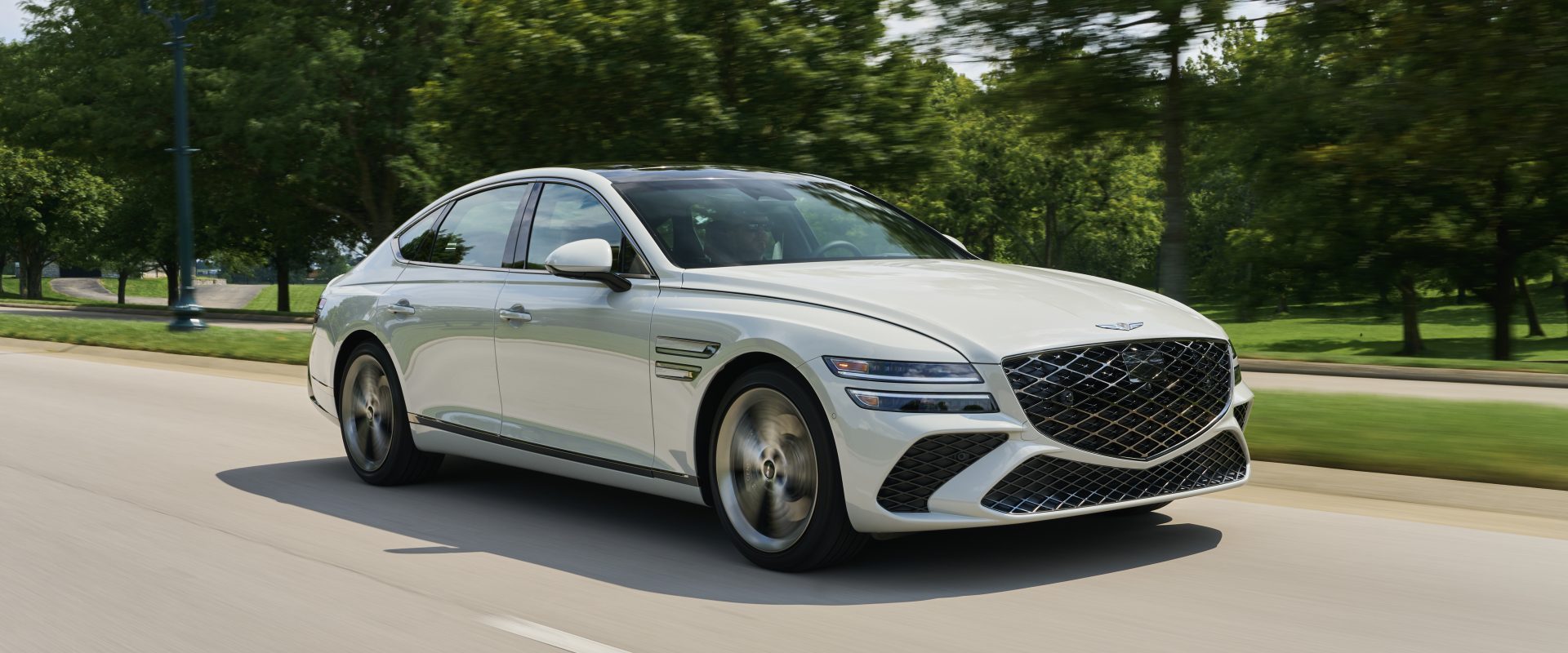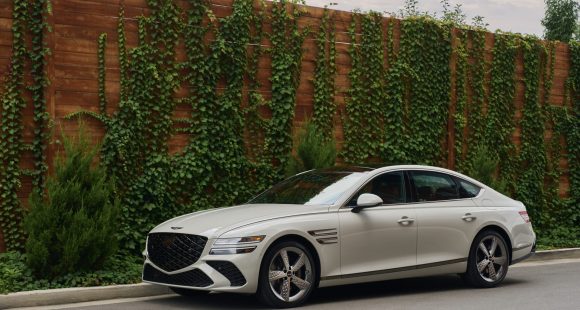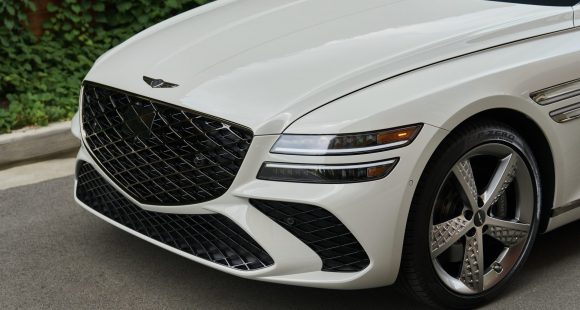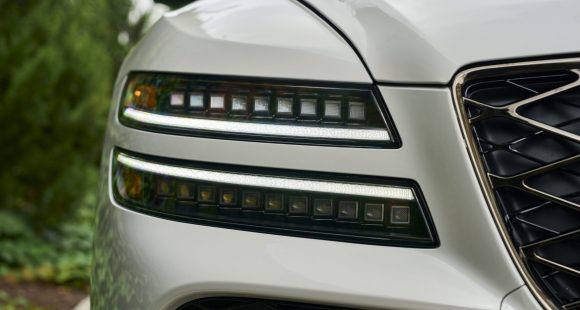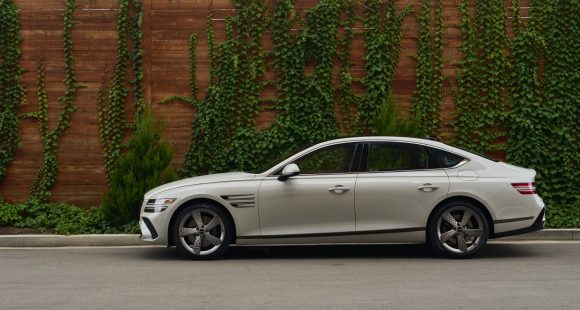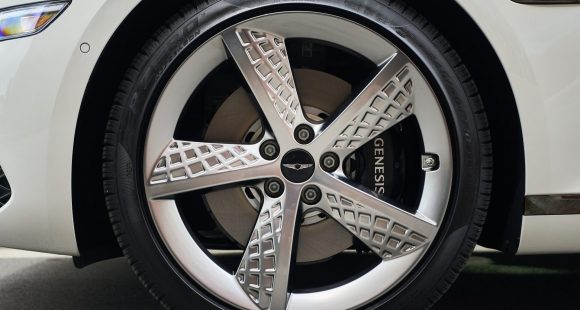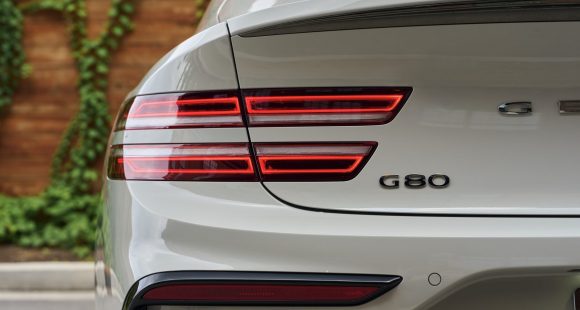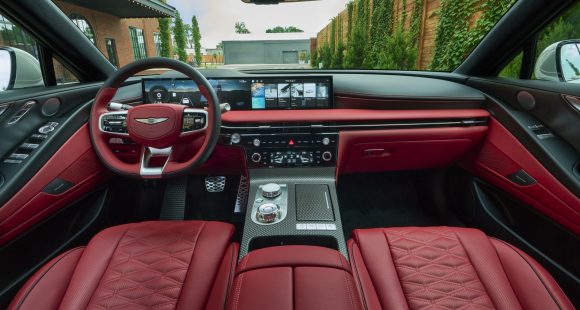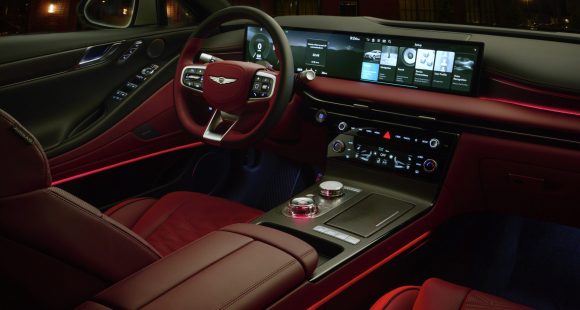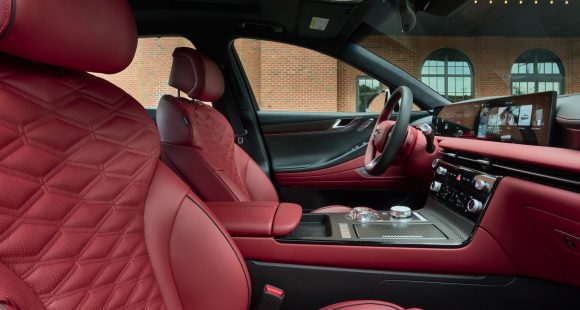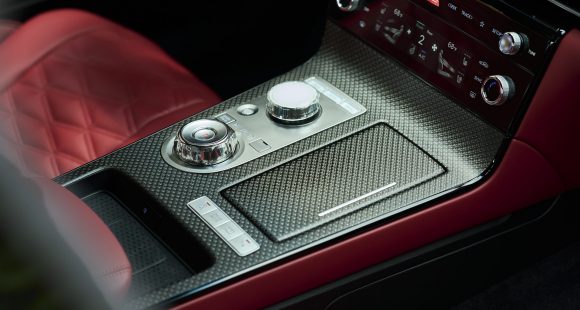2014 BMW X5
The BMW X5 arrived for the 2000 model year; a time when rival European brands were bringing high dollar sport utes to an American market that couldn’t buy up them fast enough. While the X5 has proven very popular with more than 1.3-million sold, competition grows more intense. Plus many ute buyers are downsizing to save on fuel costs. So let’s see if an all-new X5 factors in all the changes.
The mid-size 2014 BMW X5 is actually the 3rd generation of BMW’s original Sports Activity Vehicle. And while BMW has expanded into smaller segments with both the X3 and X1, it’s still the X5 that makes up the bulk of their utility sales in the U.S.
Perhaps the biggest news is that a rear-wheel-drive only sDrive X5 is now available for those that have no need for all-wheel-drive. The new-gen looks are in a word, evolutionary. But tweaks such as new headlights with flattened LED trim rings, and the increasing amount of aero elements will let those “in the know”, know you’ve upgraded.
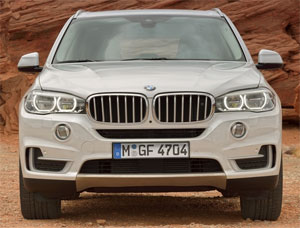 While wheelbase carries over at 115.5 inches, overall length grows by 2-inches to 193.2. It loses a little in both overall height and ride height, giving this X5 a more hunkered down look. But like the guy at the gym with the cut-off sleeves, the very high mounted fog lamps and traditional twin kidney grilles try a little too hard to look cool.
While wheelbase carries over at 115.5 inches, overall length grows by 2-inches to 193.2. It loses a little in both overall height and ride height, giving this X5 a more hunkered down look. But like the guy at the gym with the cut-off sleeves, the very high mounted fog lamps and traditional twin kidney grilles try a little too hard to look cool.
Thick body lines are still present along the sides, only now they emanate from a new front fender vent. All-in-all, not a bad looking redesign, though some of our staff did feel it appears more mini-van-ish than before. We’re all fans of the dual tailgate setup, as it makes loading heavy and bulky items easier.
While off-road credentials are probably not a high priority, the full-time intelligent all-wheel-drive system uses lots of electronic wizardry to be very capable. And should do just fine if the pending zombie apocalypse does arrive, or just on the snowy roads that we encountered here in the Mid-Atlantic this past winter.
Regardless of driving mission, you’ll find the X5 rides more like a BMW sedan than any ute. The incredibly smooth shifts of the standard 8-speed automatic transmission, and one of the most unobtrusive start/stop systems we’ve sampled, add positively to the experience.
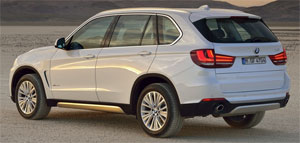 And as you would expect, it’s a great handling experience as well. Though as with most BMW’s, we mourn the lack of steering feel. But it’s hard to argue with the results, as steering is still impressively quick.
And as you would expect, it’s a great handling experience as well. Though as with most BMW’s, we mourn the lack of steering feel. But it’s hard to argue with the results, as steering is still impressively quick.
Driven aggressively, the X5 begins to feel more like an SUV, but still one that handles better than most. And this 6-banger xDrive35i certainly hooks up and launches like few SUVs. It doesn’t feel overly powerful, just a civilized whoosh of acceleration taking you to 60 in 6.2-seconds. Power continues to pour on smoothly as you work your way down the track, with firm, quick shifts coming right at red line until you clear the ¼-mile in 14.8-seconds at 95 miles-per-hour.
Powertrain options are as before, gasoline and diesel fueled inline-6s and a 4.4–liter V8 xDrive50i. The V8 is updated while the diesel in the xDrive35d is all new. But, in our test xDrive35i, the 3.0-liter gas I6 soldiers on, pumping out 300–horsepower and 300 lb-ft. of torque with the help of BMW’s TwinPower turbo.
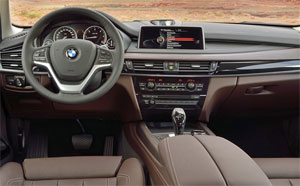 Dropping the hood and opening the doors, the highlight of the interior is easily the huge 10-inch hi-res. screen indiscreetly plopped down on the dash. It’s controlled by iDrive of course, and we think BMW has finally struck a good balance with logically placed traditional controls; making tapping into iDrive central only necessary for more detailed requests. A new touchpad write-on feature helps as well.
Dropping the hood and opening the doors, the highlight of the interior is easily the huge 10-inch hi-res. screen indiscreetly plopped down on the dash. It’s controlled by iDrive of course, and we think BMW has finally struck a good balance with logically placed traditional controls; making tapping into iDrive central only necessary for more detailed requests. A new touchpad write-on feature helps as well.
Seats, front and rear are firm, supportive, but comfortable. Back seat room is adequate but far from generous. Still, the soft close doors are a nice touch.
Government Fuel Economy Ratings are 18-City, 27-Highway, and 21-Combined. We averaged 20.2 miles-per-gallon of Premium. That Energy Impact Score is so-so at 15.7-barrels of annual oil use with 6.9 tons of CO2 emissions.
Yea, we know fuel economy could be better, but we just love the power and effortless feel of the gas I6. But, go the xDrive35d diesel and you gain 20% on MPGs and lose little else. And, the diesel is only $1,500 more than our tester, and volume leader xDrive35i which starts at $56,025.
The 2014 BMW X5 is indeed a sweet ride. When it comes to all out luxury, we still prefer a Range Rover, but the X5 actually appeals to a different buyer. One that needs an SUV, but really wants a BMW sport sedan. And, that will keep the X5 a major market factor for years to come.
Specifications
- Engine: 3.0-liter
- Horsepower: 300
- Torque: 300 lb-ft.
- 0-60 mph: 6.2 seconds
- 1/4 mile: 14.8 seconds @ 95 mph
- EPA: 18 mpg city/ 27 mpg highway
- Energy Impact: 15.7-barrels of oil/yr
- CO2 Emissions: 6.9 tons/yr
2025 Genesis G80
New Interior And New Tech Elevates G80 Sedan
Talk about bad timing. This second-generation G80 debuted at the height of a global pandemic. But that hasn’t stopped Genesis or this Bentley-on-a-budget sedan. In fact, since then, Genesis has unveiled a spectacular all-electric version and now given all G80s a makeover. So, let’s find out what a better and better-timed new G80 is ready to deliver.
Breaking into the luxury sedan scene requires going up against traditional brands with long pedigrees and legions of loyal buyers. But Hyundai has never shied away from a challenge, and has made steady progress with their Genesis brand, and hopes that a revised 2025 G80 midsize sedan will be their next step up.
Styling matters more when you’re the upstart, and the Genesis Athletic Elegance theme changes very little for ’25; just a new grille, slightly reshaped bumpers, new wheels ranging from 18 to 20 inches, and an updated color palette. The G80’s unique two-line LED headlamps get revised Micro Lens Array technology that boosts performance while minimizing the brightness for oncoming drivers.
Changes inside are much more significant with an entirely new dash and console, eliminating both the hooded gauge panel and dashtop wide info screen. Merging them together into one 27-inch wide LG panoramic display than runs from behind the steering wheel to over the center stack. There’s a bigger and more comprehensive control panel in the center stack; while the console gets less armrest coverage, more space for storage, and reshaped cupholders. The wider display is still a touchscreen, but there is also a console mounted controller if you prefer to keep it fingerprint free. Both options work well, but the controller is still too easy to confuse with the dial-like shifter.
Materials are on par if not a notch above most European luxury rivals, and there are 18 speakers to crank out 1,400 watts of premium sound from Bang & Olufsen. Top Sport Prestige trim comes with Nappa leather seats, carbon fiber trim, micro-suede materials for the headliner and pillar covers, heated armrests, head-up display, and upgraded active safety features. Front seats are immensely comfortable without feeling overly soft, and there’s plenty of comfort and room for adults in the back seat.
More Bentley than Benz; streaking down the track with European-style solidity that gives you very little indication of the high speed you’re traveling at.
Same powertrains as last year. Base power comes from a 300-horsepower 2.5-liter turbo-four; the upgrade is this 3.5-liter twin-turbo V6 that outputs 375 horsepower and 391 lb-ft of torque. Both are hitched to standard all-wheel drive. At our Mason Dixon Dragway test track, the AWD delivered enough grip for consistent slip-free launches. We hit 60 in 5.0 seconds flat. Run after run, the 3.5T pulled as strong as it sounds. All G80s work with the same paddle-shift eight-speed automatic transmission, and while shifting was silky smooth on the street, here on the track with Sport Mode and wide-open throttle they were noticeably firmer and quicker.
It was a very surreal experience in the cabin. More Bentley than Benz; streaking down the track with European-style solidity that gives you very little indication of the high speed you’re traveling at. For us, that was 105 mph in 13.4 seconds at the quarter. In addition to the G80’s Sport Mode that tightens steering, improves throttle response, adjusts shifting points, firms up the suspension, and reconfigures stability system parameters; Sport Prestige trim adds rear-wheel steering and an electronic limited slip differential. But, even with all of that, it didn’t feel overly sporty in our handling course. Now, we were able to comfortably carry quite a bit of speed through the cones, but there was just an overall soft, somewhat disconnected and heavy presence that had us unsure of how hard we could push. Sport Prestige also adds upgraded performance brakes. They were plenty capable, bringing this 4,600-lbs. luxury liner consistently down from 60 in just 104 feet with little fade.
Government Fuel Economy Ratings for the six-cylinder are 16 City, 24 Highway, and 19 Combined. We averaged a good 21.3 mpg of Premium. Still, that’s a slightly below average Energy Impact Score, using 15.7 barrels of oil annually with 7.8 tons of CO2 emissions.
Considering the amount of luxury packed into the G80, its $58,350 starting price, even though slightly higher than last year, remains pretty remarkable. It’s a substantial step up to the 3.5T though, as it begins at $70,850.
Genesis has existed as a standalone luxury brand for just less than a decade, and it has indeed been making steady progress into what is surely the hardest segment of all to master. The 2025 Genesis G80 sedan continues to impress and is a great option for luxury-minded buyers who prioritize true value over badges.
Specifications
As Tested
- Engine: 3.5-liter twin-turbo V6
- Transmission: eight-speed automatic
- Horsepower: 375
- Torque: 391 lb-ft
- EPA: 16 City | 24 Highway | 19 Combined
- 0-60 mph: 5.0 seconds
- 1/4 Mile: 13.4 seconds at 105 mph
- Braking, 60-0 (avg.): 104 feet
- MW Fuel Economy: 21.3 mpg (Premium)







